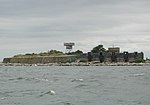Fort Monroe

Fort Monroe is a former military installation in Hampton, Virginia, at Old Point Comfort, the southern tip of the Virginia Peninsula, United States. It is currently managed by partnership between the Fort Monroe Authority for the Commonwealth of Virginia, the National Park Service, and the city of Hampton as the Fort Monroe National Monument. Along with Fort Wool, Fort Monroe originally guarded the navigation channel between the Chesapeake Bay and Hampton Roads—the natural roadstead at the confluence of the Elizabeth, the Nansemond and the James rivers. Until disarmament in 1946, the areas protected by the fort were the entire Chesapeake Bay and Potomac River regions, including the water approaches to the cities of Washington, D.C., and Baltimore, Maryland, along with important shipyards and naval bases in the Hampton Roads area. Surrounded by a moat, the six-sided bastion fort is the largest fort by area ever built in the United States.During the initial exploration by a mission headed by Captain Christopher Newport in the early 1600s, the earliest days of the Colony of Virginia, the site was identified as a strategic defensive location. Beginning by 1609, defensive fortifications were built at Old Point Comfort during Virginia's first two centuries. The first was a wooden stockade named Fort Algernourne, followed by other small forts. However, the much more substantial facility of stone that became known as Fort Monroe (and adjacent Fort Wool on an artificial island across the channel) were completed in 1834, as part of the third system of U.S. fortifications. The principal fort was named in honor of U.S. President James Monroe.Although Virginia became part of the Confederate States of America, Fort Monroe remained in Union hands throughout the American Civil War (1861–1865). Union General George B. McClellan landed the Army of the Potomac at the fort during Peninsula campaign of 1862 of that conflict. The fort was notable as a historic and symbolic site of early freedom for former slaves under the provisions of contraband policies. For two years following the war, the former Confederate President, Jefferson Davis, was imprisoned at the fort. His first months of confinement were spent in a cell of the casemated fort walls that is now part of its Casemate Museum. Around the turn of the 20th century, numerous gun batteries were added in and near Fort Monroe under the Endicott program; it became the largest fort and headquarters of the Harbor Defenses of Chesapeake Bay. In the 19th and 20th centuries it housed artillery schools, including the Coast Artillery School (1907–1946). The Continental Army Command (CONARC) (1955–1973) headquarters was at Fort Monroe, succeeded by the United States Army Training and Doctrine Command (TRADOC) following a division of CONARC into TRADOC and United States Army Forces Command (FORSCOM) in 1973. CONARC was responsible for all active Army units in the continental United States. TRADOC was headquartered at the fort from 1973 until it was moved to Fort Eustis in 2011.Fort Monroe was deactivated September 15, 2011, and many of its functions were transferred to nearby Fort Eustis. Several re-use plans for Fort Monroe are under development in the Hampton community. On November 1, 2011, President Barack Obama signed a proclamation to designate portions of Fort Monroe as a national monument. This was the first time that President Obama exercised his authority under the Antiquities Act, a 1906 law to protect sites deemed to have natural, historical or scientific significance.
Excerpt from the Wikipedia article Fort Monroe (License: CC BY-SA 3.0, Authors, Images).Fort Monroe
North Willard Avenue, Hampton Phoebus
Geographical coordinates (GPS) Address Website External links Nearby Places Show on map
Geographical coordinates (GPS)
| Latitude | Longitude |
|---|---|
| N 37.003611111111 ° | E -76.3075 ° |
Address
Fort Monroe National Monument
North Willard Avenue
23663 Hampton, Phoebus
Virginia, United States
Open on Google Maps








